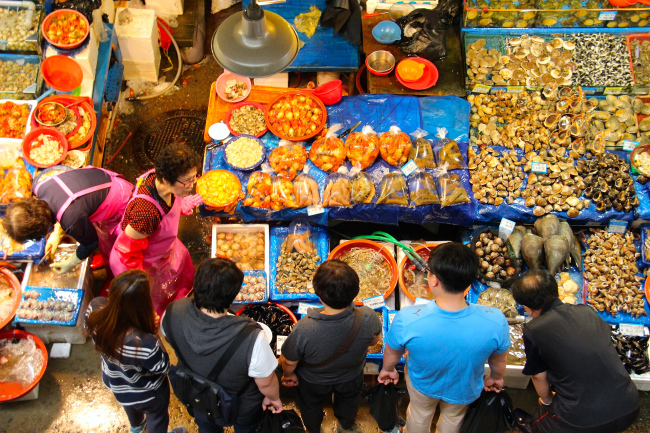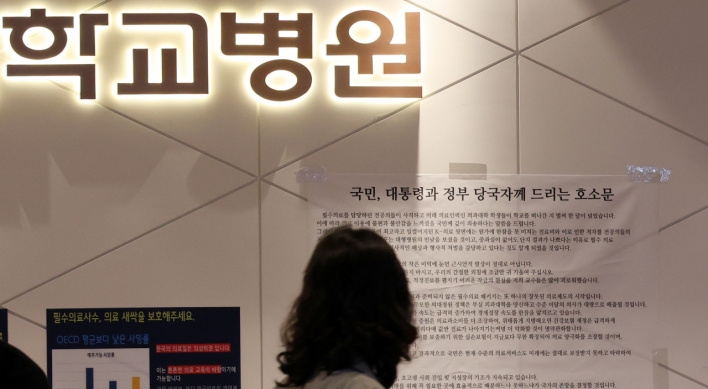[Markets & Merchants] A taste of the sea at Noryangjin fish market
By Korea HeraldPublished : March 9, 2015 - 18:50
Although Dongdaemun and Namdaemun tend to dominate many lists of “must-see markets” in Seoul, small-scale markets that are equally full of history and character are scattered across the city. This is the second installment of a series introducing traditional local markets. ― Ed.
The sheer chaos, yet utterly delectable sights and sounds of catcalling, haggling, crowds and occasional Dungeness crab or live octopus attempting its escape is merely a fleeting descriptive taste of Seoul’s largest traditional fish market ― the Noryangjin Fisheries Wholesale Market.
Located in Dongjak-gu, Seoul, the market first opened its doors in 1927 as the Gyeongseong Susan ― one of the largest fish markets in the entire country. In 1971, it was renamed and relocated to its current location and remains Korea’s most iconic seafood wholesale market.
Whether it’s the conventional flounder, shrimp, lobster and clam, or the more outlandish jellyfish, sea quirt or the notorious Urechis unicinctus ― spoon worm, popularly called “penis fish” for its phallic appearance ― there are more than 830 seafood varieties that can be purchased at the market. So if someone claims they couldn’t find the ocean crustaceans and underwater creatures that they were searching for, then they probably weren’t looking hard enough.
The sheer chaos, yet utterly delectable sights and sounds of catcalling, haggling, crowds and occasional Dungeness crab or live octopus attempting its escape is merely a fleeting descriptive taste of Seoul’s largest traditional fish market ― the Noryangjin Fisheries Wholesale Market.
Located in Dongjak-gu, Seoul, the market first opened its doors in 1927 as the Gyeongseong Susan ― one of the largest fish markets in the entire country. In 1971, it was renamed and relocated to its current location and remains Korea’s most iconic seafood wholesale market.
Whether it’s the conventional flounder, shrimp, lobster and clam, or the more outlandish jellyfish, sea quirt or the notorious Urechis unicinctus ― spoon worm, popularly called “penis fish” for its phallic appearance ― there are more than 830 seafood varieties that can be purchased at the market. So if someone claims they couldn’t find the ocean crustaceans and underwater creatures that they were searching for, then they probably weren’t looking hard enough.

Noryangjin is the perfect aquarium-like atmosphere for visitors wanting to actually taste what’s behind the glass and in the tanks. Upon entering the bustling giant market with more than 700 shops, the pungent smell of fish and various aquatic perfumes will hit the senses instantly.
The 24-hour fish market is always buzzing and is in no way the ideal destination for those seeking a quiet, peaceful stroll through one of the city’s handful of remaining traditional markets. Regardless of whether one is a local or a tourist, all visitors will inevitably be the target of catcalling from vendors trying to lure customers to their tanks.
“What makes this market different from all the other traditional markets in Seoul ― aside from the fact that it is the largest fish market in the city ― is actually the layout of the market itself,” said a Noryangjin worker surnamed Kim.
“It’s really big and there’s plenty of open space compared to your more smaller traditional markets, but we are still set up in a way that it feels really friendly and vibrant because we are talking and engaging with the customers walking by,” she added.
Undoubtedly, one of the most adventurous aspects of Noryangjin is the exciting discovery process of all the sea life, as it is almost guaranteed that visitors will spot a fishy creature that they never even knew existed ― let alone eaten.
“I know that when some people come here, especially foreigners, the market can seem a bit intimidating and a few may be a bit scared to try out some of the things they see,” said Kim. “But this is what the market is all about, it’s about the experience you get from walking around.”
In 2011, the Seoul Metropolitan Government polled nearly 2,000 foreign tourists and found that alongside Namsan Mountain and Myeongdong, Noryangjin fish market is one of the most popular tourist attractions in Seoul. However, despite it being on many travelers’ “must-see” list, many vendors voice their concerns that most tourists are missing out on experiencing the raw core of what Noryangjin has to offer.
“We get a ton of tourists who come and visit here, but one of the biggest things I have noticed is that a majority of the Western visitors tend to just come in, take a few picture, and then leave,” said Song Young-sung, a fish merchant for 20 years.
As a longtime market vendor who currently sells fresh jellyfish ― certainly an item not placed on a Westerner’s typical seafood menu ― Song says that although he has noticed a huge flux in the number of tourists over the past decade, he still feels that many people’s inhibitions prevent them from enjoying the nonvisual aspects of the market.
“I know it has a lot to do with many Western cultures not being accustomed to eating raw seafood like Asian cultures, but I definitely think it’s a shame for people not to at least taste some of the fresh seafood we have here, whether it’s raw or cooked,” he added.
One of the other dynamic and venturous sides of Noryangjin is the fact that this wholesale market does not limit itself to bulk items being purchased to-go, but geared to all buyers, whether it’s simply buying one small fish or an entire buffet line of seafood.
The market is also crammed with restaurants that prep up raw or cook one’s seafood purchases ― a must-do for those who want to truly immerse themselves in the rapid and rousing spirit of the Noryangjin Fisheries Wholesale Market.
If you go:
The Noryangjin Fisheries Wholesale Market in Dongjak-gu and can be reached by taking subway line 1 to Noryangjin Station off Exit 1. The market is open 24 hours a day, seven days a week.
By Julie Jackson (juliejackson@heraldcorp.com)
-
Articles by Korea Herald



![[Herald Interview] 'Amid aging population, Korea to invite more young professionals from overseas'](http://res.heraldm.com/phpwas/restmb_idxmake.php?idx=644&simg=/content/image/2024/04/24/20240424050844_0.jpg&u=20240424200058)















